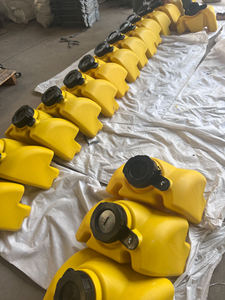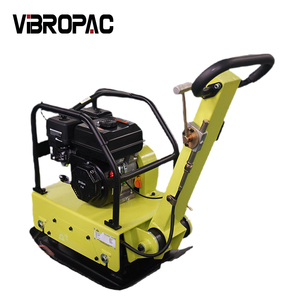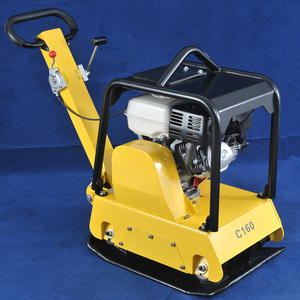
All categories
Featured selections
Trade Assurance
Buyer Central
Help Center
Get the app
Become a supplier

(3576 products available)














































This is widely known as the hand ramming stone plate. The main compaction plate on the appliance vibrates and generates resistance. As the plate moves, it compacts loose material. It's very effective in compacting soils in difficult places and small areas.
These are designed for tougher work. They can compact thicker layers of soil. The heavier the compactor, the deeper the vibration goes, making it great for roads and bigger projects.
As one of the most commonly used tools in this realm, the vibrating roller compactor has two smooth cylindrical drums. Both of these drums vibrate. The vibrations help to pack the soil correctly and make it even smoother. These rollers are good for flattening big areas, especially when constructing roads or paving large surfaces. Many of these rollers now have special controls that let operators change how the roller vibrates based on the job's needs.
A vibrating rammer compactor excels in tight spots. Think of small corners or narrow pathways. It uses a ramming head that vibrates to compact soil in hard-to-reach areas. This makes it ideal for jobs near buildings or in small construction zones. Its compact design helps it fit into areas where bigger machines can't go.
Every building, road, and bridge requires a strong base to last long. In this realm, a compactor vibrating mechanism is highly instrumental in making this possible. It helps pack the soil on construction sites, ensuring that structures stand on a solid foundation. Proper soil compaction leads to fewer issues like cracks or settling in the future.
People use compactors with vibrating mechanisms to create smooth and even roads. Before laying asphalt or concrete, the road base must be solid. These compactors ensure the ground below the road can support the weight of vehicles. This leads to roads that last longer and require less maintenance over time.
In large gardens or parks, a flat surface is essential for pathways and ponds. Vibrating compactors help make these areas level and prepare them for planting grass or putting in plants. They are also used to create ideal grounds for paver blocks installation. The compacted soil provides a stable base for the pavers, ensuring they don't sink or shift.
The main task of vibrators in these spaces is to help extract materials like coal, minerals, and rocks from the earth. They are integral in preparing the land for mining activities. They compact the soil, making it easier to dig deep and safely reach vital resources.
This is a unique area where soil stability directly impacts major structures. Compactors in this space ensure the soil on bridges and dam foundations can bear heavy loads. They act as stabilizers during intense weather patterns, ensuring structures don't collapse.
In places like factories and businesses, ground stability is crucial for buildings and equipment. In these areas, people apply this equipment to compact the ground. This prevents uneven surfaces and reduces the chances of the floor cracking or sinking. It also promotes even drainage and water distribution.
Applying the right fuel on the device makes it produce the right amount of power without harming the environment. It's vital to watch the fuel level. A low fuel count can make the device overheat or stop working. A stunning fact is that people can reduce emissions by using filters or newer fuels.
The speed should be maintained at a reasonable level, especially for large machineries. Going too fast can result in unwanted soil ripples. This results in a poor-quality flat surface. High speeds can also damage fragile compacting elements. Working at normal speed allows for better fuel economy and enhanced operator comfort.
Excessive vibrations can harm the internal elements of a Compactor Vibrating mechanism. An operator should look for anti-vibration techniques and pads. They decrease vibrations on the operator. Less vibration means operators can work for longer hours without feeling tired. Another trick is tightening all the compactor's vibrating elements. Going over the same space multiple times will help even out the ground. This leads to a decrease in the total amount of time and vibrations used.
It is important for various tools to have emergency shutoff switches for enhanced operator safety. Maintaining such tools provides users with today's operation and safety features. In working outdoors, people should pay attention to changing weather conditions. Rain, wind, or storms can make the work area risky. Work should stop immediately until the weather settles down.
Regular inspection of belts and other moving components is very important. The inspection helps to identify loose or damaged parts and replace them instantly. Using worn-out parts can lead to unexpected component failure. People should ensure that all components are securely fastened. Loose items can rattle during use. This leads to accidents or harm to the inner tools.
A dangerous condition linked to this mechanism is electrical parts coming into contact with any liquid. Great caution should be exercised when handling a damp or wet device. All electrical elements should be completely dried before use. Any damaged electrical component should be fixed before further use.
A1. It offers safety to construction activities by improving soil bearing ability. This, in turn, reduces soil settlement and enhances drainage.
A2. It stabilizes the soil particles and keeps water from washing them away. This reduces the chances of erosion on a construction site.
A3. Soil compaction creates a less suitable home for harmful insects and pests. This, therefore, reduces their population on construction sites.
A4. It is usually measured with a nuclear density gauge, the sand cone method, or proof rolling. The test is chosen based on the project size and available tools.
A5. It normally handles up to 6 inches of thick lift. Anything more than this requires multiple passes to achieve the desired density.